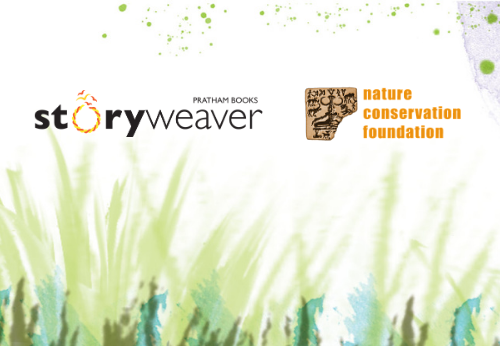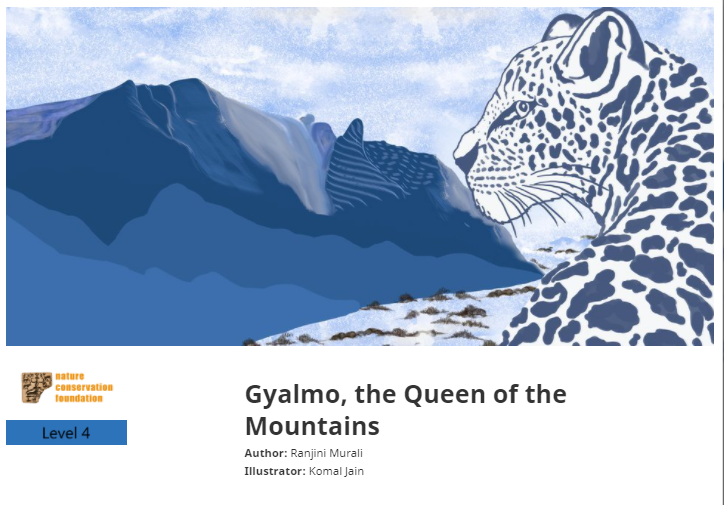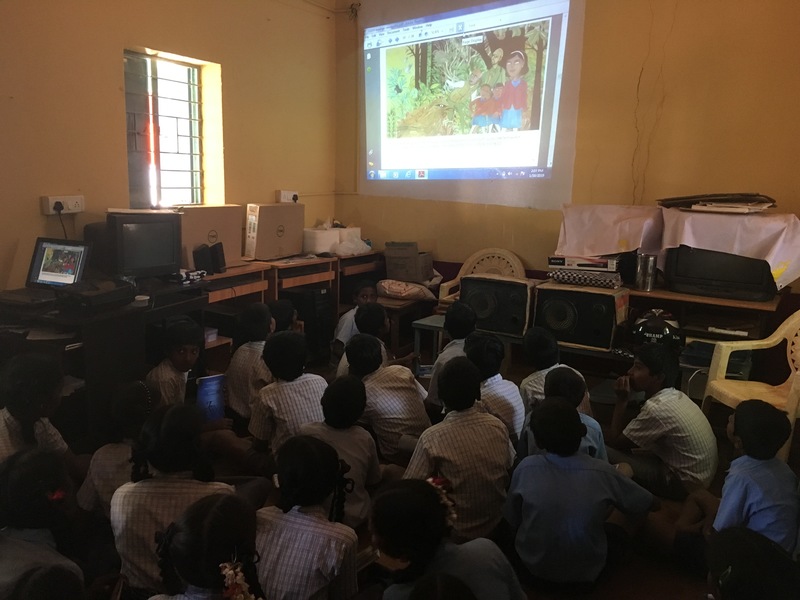StoryWeaver and Nature Conservation Foundation celebrate World Wildlife Day with the launch of books on India's wildlife
Posted by Pallavi Kamath on March 03, 2021Post written in collaboration with the team at Nature Conservation Foundation
On World Wildlife Day 2021, StoryWeaver is pleased to announce a partnership with the Nature Conservation Foundation (NCF), an organisation that works towards conservation of India’s unique wildlife heritage. The aim of this partnership is to create more stories about nature, birds, and wildlife, that inspire children to develop a love of the natural world that they will inherit.

Through these stories, NCF's scientists and naturalists who work in a range of wildlife habitats - from coral reefs and tropical rainforests to the high mountains of the Himalayas - relive their experience of studying and encountering the wild.
We are delighted to launch the first 2 books: Gyalmo, the Queen of the Mountains and Birds That Sing Their Name.

In Gyalmo, the Queen of the Mountains, Koyna and her friend Lobzang are in Spiti Valley, trying to spot the most elusive cat in the world, while Gyalmo, the snow leopard, watches from a distance as they try their best to see her. Read this humorous tale of humans and leopards by Ranjini Murali. Illustrated by Komal Jain.

In Birds That Sing Their Name, Jegan, a scientist working in bird conservation, talks about birds and the beautiful songs they sing in the wild. How do birds get their names? Sometimes people name them after their colours, size and food they eat. Sometimes, they get their names from the way they call or sing. Come meet some of the birds that sing their names. Read this riveting story on sounds by P Jeganathan, illustrated in watercolours by Ravi Jambhekar. We can still hear the echo of these songs!
Happy reading!
These books are an effort by the Nature Communications team at Nature Conservation Foundation to encourage awareness and appreciation of India’s wildlife in children and adults. We are delighted to have them on board as publishers on StoryWeaver.
Digital Libraries in schools of rural Karnataka
Posted by Vineetha Menon on February 04, 2019
Suganya, from the Partnerships team, takes us on a journey to Tumkur where India Literacy Project is implementing a Multi-Dimensional Learning Spaces program with the government schools.
Getting there
The two-hour ride to Tumkur through traffic and on roads under-construction had taken a toll on our energy levels. But meeting children filled with enthusiasm for the read-aloud instantly put a smile back on our faces.
We were greeted by Latha, an India Literacy Project (ILP) Facilitator. She has been instrumental in implementing StoryWeaver content as a part of their Multi Dimensional Learning Space (MDLS) programme. Over 16 facilitators who work across 30 schools in Tumkur, Karnataka, identify schools in need, coordinate with partner organisations and develop a programme to help children not only with academics but also overall personality development. They provide schools with digital infrastructure, reading material and teacher guides, and also help them implement the programme in the classroom.
Story reading
Children were excited to get started with the read-aloud session. They had picked Smile Please for this. One of the children volunteered to read the story, and the others joined in. Whenever she had difficulty with a sentence or the pronunciation of a word, the class teacher and the ILP facilitator chipped in to help her out.
We were awed by the children’s enthusiasm and decided to do an impromptu reading session for them. One of our team members stepped in and interacted with the children in Kannada, doing another reading. It was way past the children’s lunch time, but they wanted their fill of stories first.
While the students were getting ready to enjoy their mid-day meal, we bid goodbye and continued our journey to visit more children.
More stories…
Once we reached the next school, we met with the headmaster and the ILP facilitator, Tejaswini. Teachers there have found it easier to introduce science and mathematics concepts using our STEM books. Children operate the computer and the projector during their free time to read stories on their own.
Without further ado, we began another read-aloud session with the children. This time, children had decided on Welcome to the Forest. Children enjoyed the narrative and also gained insights about the forest and animals that call it home. We asked the children, “What is your favourite book and which story do you enjoy reading aloud in class?”. We were happy to hear varied responses, but Dum Dum-a-Dum Biryani! turned out to be everyone’s favorite.
We were glad to see the children read and relate to the characters portrayed in our books. We believe that an incredible future awaits the children. With partners like ILP, we get that much closer to making our vision a reality.
Be the first to comment.
StoryWeaver Spotlight: Nivedha
Posted by Remya Padmadas on July 01, 2019Nivedha is a Physics graduate currently working in the field of education. She enjoys taking science to kids through stories. She has translated many stories to Tamil for Pratham Books including 'Talking in Twos' and 'This is How You Count Eggs'. You can read her stories The Girl Who Thinks in Numbers: Data Warrior Prukalpa Sankar and The Scavenger Hunt on StoryWeaver. 
Q: Can you tell us anything about yourself and your job that would surprise us :) ?
I am a mildly mischievous person with good observation skills. No wonder I chose to study science and became a physics graduate eventually. Now I work in an education-based organisation where I develop content for school kids. While designing language lessons, I try to include storytelling elements to it. It’s quite interesting!
Q: What is your personal relationship to language and/or translation?
Being a single child to my parents, books have been the biggest companion to me since childhood. I remember reading books even when I couldn’t understand the meaning of most parts of the text. Language feels like a cosy and comfortable space that my mind loves going to!
Q: When you’ve been given a story to translate, what’s your process, and how long does it generally take?
First, I read the story three to four times. During the initial reads, I consciously ignore the fact that I am reading it for the purpose of translation. It helps to grasp how a particular story might feel/appeal to a reader.
In the next step, I read about the region/culture where the story happens. For STEM stories I make sure that I revise/read the science concepts that are dealt with. This process I stretch across a few days to a week and when I sit to write it down it doesn’t take more than a few hours.
Q: In your opinion, what do stories in translation bring to young readers?
Children love exploring new things. These stories provide an exposure to other cultures and people. I believe it helps the kids to know about the differences existing among us or feel that it is okay to be different.
Q: How did you cultivate the skills needed to translate books for children?
Translation is relatively a new thing to me and I have a lot to learn. I read children stories and translated stories. Reading translation related discussions on digital platforms also help me. I also watch child centred cartoons like ‘Peppa Pig’ where an episode is like a visual short story of 5 minutes and then imagine how we can give similar experience through the text .
Q: What was the experience of translating a children’s book like, compared to translating for adults?
The exposure and worldview that a child has is very different from what an adult would have. So this has to be kept in mind too. Also, while translating for adults I feel there is a liberty to use slang, but for children had to go back to the basic words. During this process, I also learnt(had to learn) new words whose usage is not very common in spoken language.
Q: You are also a Physics graduate who loves the subject. How is the experience of translating STEM based stories? Are there any particular experiences/opinions from this experience?
I believe children grasp things quickly when it’s told as a story spun around their world and experiences. In that way, translating STEM based stories make me happy as it helps in taking science to kids in an interesting way.
Especially, while translating the story “The Scavenger Hunt”, I was delighted at how the basic concept of filtration was taken and woven into the story. When Lajjo (the main character) goes in search of tools, we could see that how a tool/object is accessed/placed varies for each culture. It gave me an insight that our interaction with the material world is not the same and thus teaching science in the same way to everyone may not work in all cases.

Q: What is the hardest thing about translating from English to Tamil? How do you navigate words or phrases that are tricky to translate?
I find translating the technical words/jargons to Tamil the hardest. Most times people would be familiar with the actual English terms than Tamil. In that case I refer to dictionaries, other tests and try to use an easier, relatable Tamil equivalent. I also cross check with my friends if they can understand that word/phrase.
Q: How else do you think we can join hands to take more stories to more children in more languages?
Book fairs are a great way to reach Children. The publications concentrating on children and young adult literature can collaborate and come up with a dedicated stall for them. (This from my experience in Chennai book fair. Though many kids come, availability of books in regional languages is not sufficient.)
This platform can also be used to attract talent who are interested in children’s literature.
Q: What type of person do you think makes the best translator for children stories?
Anyone who has a love for language and is open to learn from everyone and everything can make a good translator.
Q: Do you have any advice for anyone interested in becoming a translator?
I think I still am in a place to receive a lot of it? 😊 Anyways, I would say to be open to learning and observe the language of people around you. It helps a lot.
Q. A book you would recommend to other translators?
Eriyum panikkaadu (எரியும் பனிக்காடு) by R. Murugavel (Originally written in English by P.H.Daniel). I didn’t even have the slightest thought that ‘Eriyum panikkaadu’ could be a translated book when I first read it. Such was the flow of text in the translation. Isn’t that an aim of every translator!
Be the first to comment.